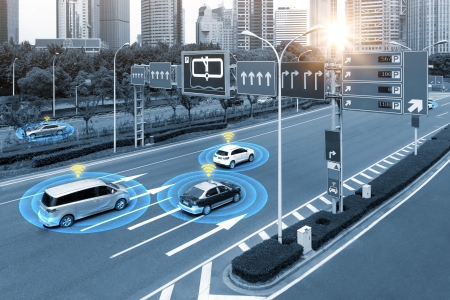In the interaction between driver and self-driving vehicle, several aspects are of importance. Interaction problems may arise if one of the aspects is found wanting. The literature often mentions the following aspects: mode awareness, calibrated trust, due attention and retention of skills. Below, each of the aspects is discussed. Problems can be diminished or even prevented by appropriate communication between driver and vehicle. How this may be realised is discussed by answering the question How can self-driving vehicles, drivers and other road users communicate?.
Mode awareness
Mode awareness implies that the driver is, at all times, aware of the state or mode of the self-driving vehicle: which party is responsible for (a part of) the driving task, the driver or the vehicle? This should ensure that the drivers are aware of their responsibilities and able to act accordingly. If mode awareness is wanting, mode confusion may arise. This implies that the driver is confused about the prevailing state of the vehicle. This may result in hazardous situations since the driver’s confusion may cause him to take an inappropriate course of action. Such a course of action is also called a mode error [36]. A driver may, for instance, wrongly believe that the system that keeps a safe distance to a preceding vehicle is active and may, therefore, be (too) late to hit the brakes.
Calibrated trust
Calibrated trust implies that the driver’s trust in the self-driving vehicle is appropriate and realistic. The extent to which the driver trusts the vehicle should correspond to what the vehicle is actually capable of. When trust is excessive, this may result in improper and therefore hazardous use of the vehicle [37]. On the other hand, too little trust, or even distrust, may result in disuse of the automation features, which means potential safety benefits would be lost [38].
Due attention
The driver should focus attention on activities that are critical to road safety. However, self-driving vehicles of Level 3 and higher (see the question Which levels of driving automation can be distinguished?) enable drivers to engage in activities that are not related to the driving task, such as texting. But if drivers are responsible for the driving task, it is important that this task should gain their attention. Therefore, they should stop engaging in activities unrelated to the driving task in good time, and focus their attention on the driving task whenever required. At critical times, drivers must neither be distracted nor too tired. It may be harder to be properly focused in a self-driving vehicle than in a conventional vehicle [39] [40]. It may, for example, be very tiring to continuously stay focused on the driving situation without being actively involved in the driving task (see SWOV fact sheet Fatigue).
Retention of skills
As the level of automation increases, active driver participation will decrease. In the long run, this may reduce driving skills [41]. Particularly in the case of Level 3 self-driving vehicles, this is considered a potential problem. At this level, the driver remains responsible for taking over the driving task when required, whereas in certain conditions the vehicle can drive by itself. Drivers should obviously retain their driving skills, even when they have not needed to rely on these skills for some time.
